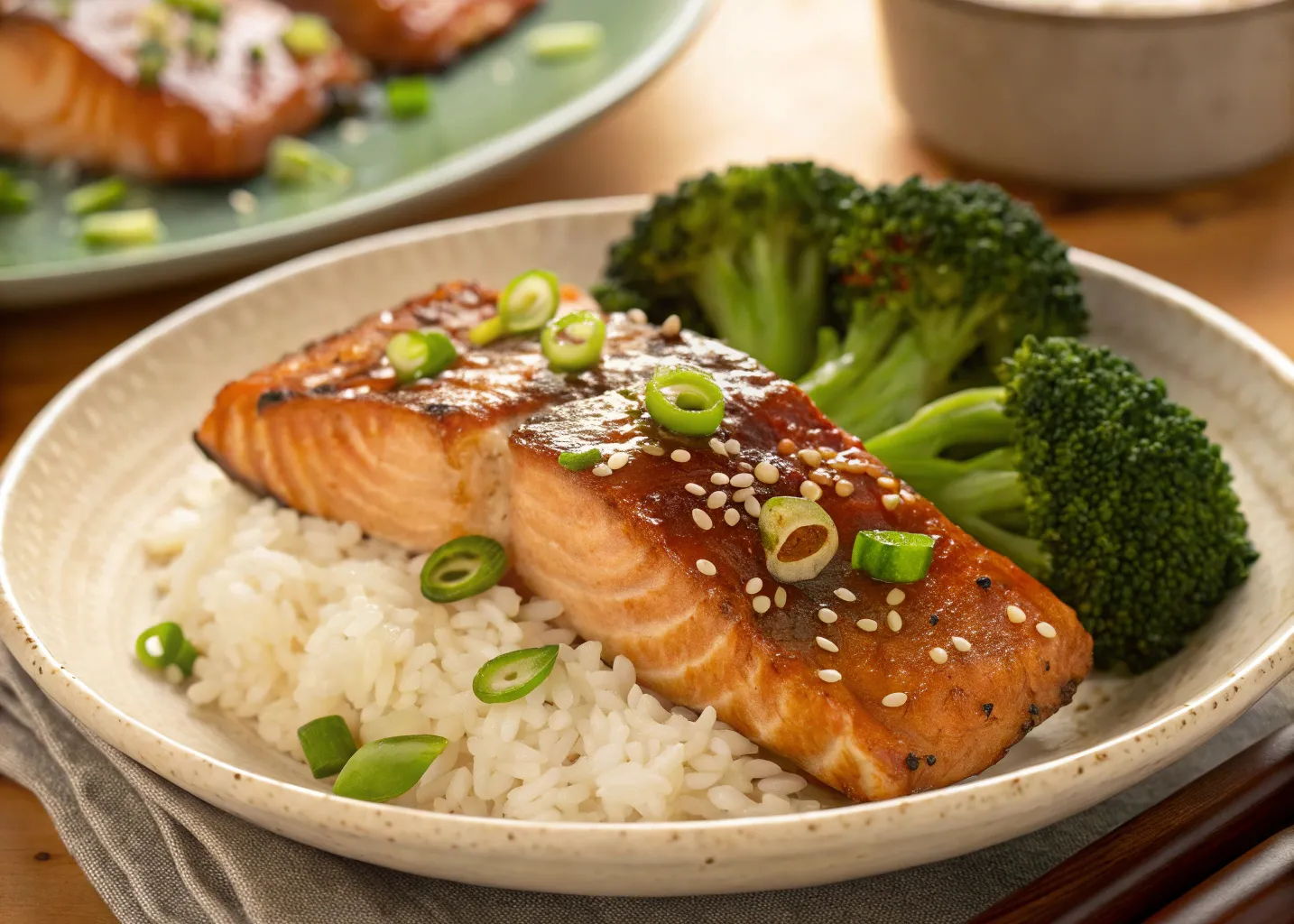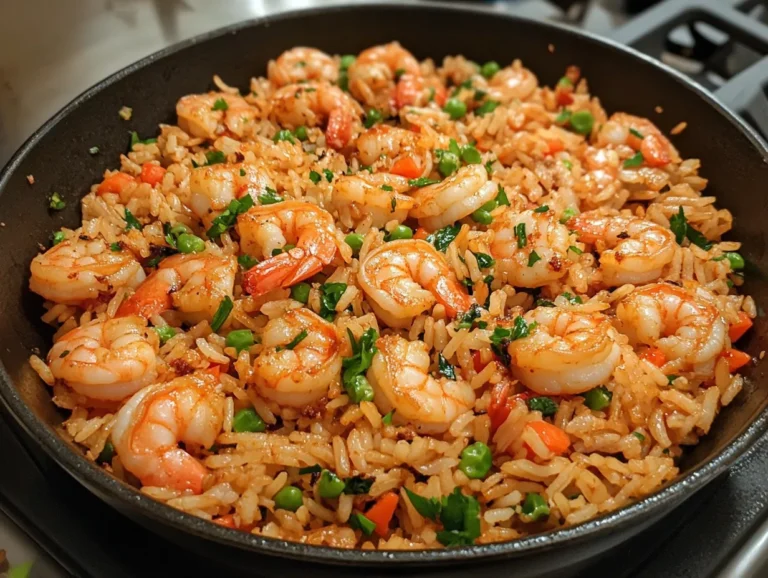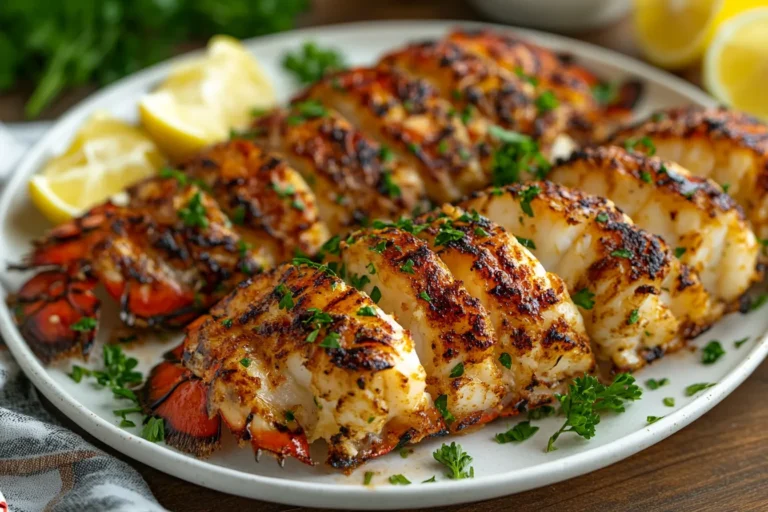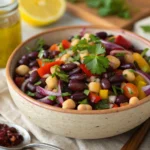If you’re craving something flavorful, fast, and packed with protein, you can’t go wrong with a teriyaki salmon recipe. This dish checks all the right boxes—it’s sweet, savory, juicy, and comes together in under 30 minutes. Whether you’re making dinner for the family or meal prepping for the week, teriyaki salmon is your go-to recipe for a healthy, satisfying meal.
In this guide, we’ll break down everything you need to know: why teriyaki pairs so well with salmon, how to choose the freshest fish, what ingredients to use for the perfect marinade, and the absolute tastiest way to cook it. Stick around for step-by-step instructions, side dish ideas, expert-level cooking tips, and answers to common questions to help you master this dish at home.
Let’s dive into what makes this recipe a weeknight winner.
Why Teriyaki Sauce Works So Well with Salmon
The Perfect Flavor Pairing: Umami Meets Omega-3s
Salmon is a rich, oily fish with a naturally buttery texture and deep flavor. Teriyaki sauce brings out its best qualities with a mix of salty soy, sweet sugar or honey, and a punch of ginger and garlic. This combination creates a balanced glaze that enhances the salmon’s taste without overpowering it.
This pairing works so well because of umami—the fifth taste. Soy sauce and cooked fish are both umami-rich, making them a powerful match. Add in the sweetness of mirin or brown sugar, and you’ve got a mouthwatering contrast of flavors that keeps you going back for another bite.
Does Teriyaki Sauce Go Well with Salmon? Here’s Why It’s a Yes
Absolutely. Teriyaki and salmon are one of those culinary power couples—each elevates the other. The sauce’s sweet-salty profile cuts through the richness of the fish, while the caramelization from cooking adds complexity and depth. When done right, it forms a sticky, flavorful crust that seals in moisture and flavor.
If you’ve ever wondered whether to try it, don’t hesitate. This is one recipe you’ll keep in rotation.
Balancing Sweetness, Saltiness, and the Natural Richness of Salmon
The key to perfecting this dish lies in balance. Use low-sodium soy sauce if you’re watching salt levels, and consider adding a splash of fresh orange juice or a drizzle of honey for natural sweetness. A touch of acidity from rice vinegar or lemon juice will round it out beautifully.
This dish isn’t just delicious—it’s also endlessly flexible. Whether you’re aiming for something light or a comfort-food classic, this flavor combination works in your favor.
Choosing the Best Salmon for Teriyaki Dishes
Wild-Caught vs. Farm-Raised: Which is Better for Flavor and Texture?
Both wild-caught and farm-raised salmon can work for this recipe, but they do offer different results:
- Wild-caught salmon has a firmer texture, deeper color, and a more pronounced flavor. It tends to be leaner, which means it cooks a bit faster and is ideal for grilling or pan-searing.
- Farm-raised salmon is more widely available and usually more affordable. It has a higher fat content, giving it a melt-in-your-mouth texture and making it less likely to dry out in the oven.
For a teriyaki salmon recipe, both types work well. If you’re aiming for the crispiest exterior with that caramelized glaze, wild salmon is your best bet. If you want a rich, tender interior, farm-raised might be more your style.
If you’re interested in more traditional uses for salmon, check out this classic salmon patties recipe—a nostalgic favorite with simple ingredients.
Best Salmon Cuts for Marinating and Pan-Searing
The salmon fillet is the star of this recipe. It’s boneless, cooks evenly, and absorbs marinades beautifully. Look for fillets that are:
- At least 1 to 1.5 inches thick
- Skin-on (helps with moisture retention and prevents sticking)
- Uniform in size for even cooking
Avoid thin or uneven cuts—they tend to overcook quickly, leaving you with dry fish.
If you’re cooking for a crowd, a whole side of salmon can be marinated and baked on a sheet pan. It’s visually impressive and incredibly easy to clean up.
How to Know If Your Salmon Is Fresh and High-Quality
Freshness is key for flavor and food safety. Use these quick tips to choose the best salmon:
| Quality Check | What to Look For |
|---|---|
| Color | Bright pink to deep red |
| Smell | Clean and mild—not fishy |
| Texture | Firm and bouncy to the touch |
| Skin | Shiny with tight scales |
| Packaging (if frozen) | Vacuum-sealed, no ice crystals |
Pro Tip: If you’re buying frozen, thaw it slowly in the fridge overnight. Avoid thawing at room temperature, which can lead to uneven texture and potential bacteria growth.
The Ultimate Teriyaki Marinade for Salmon
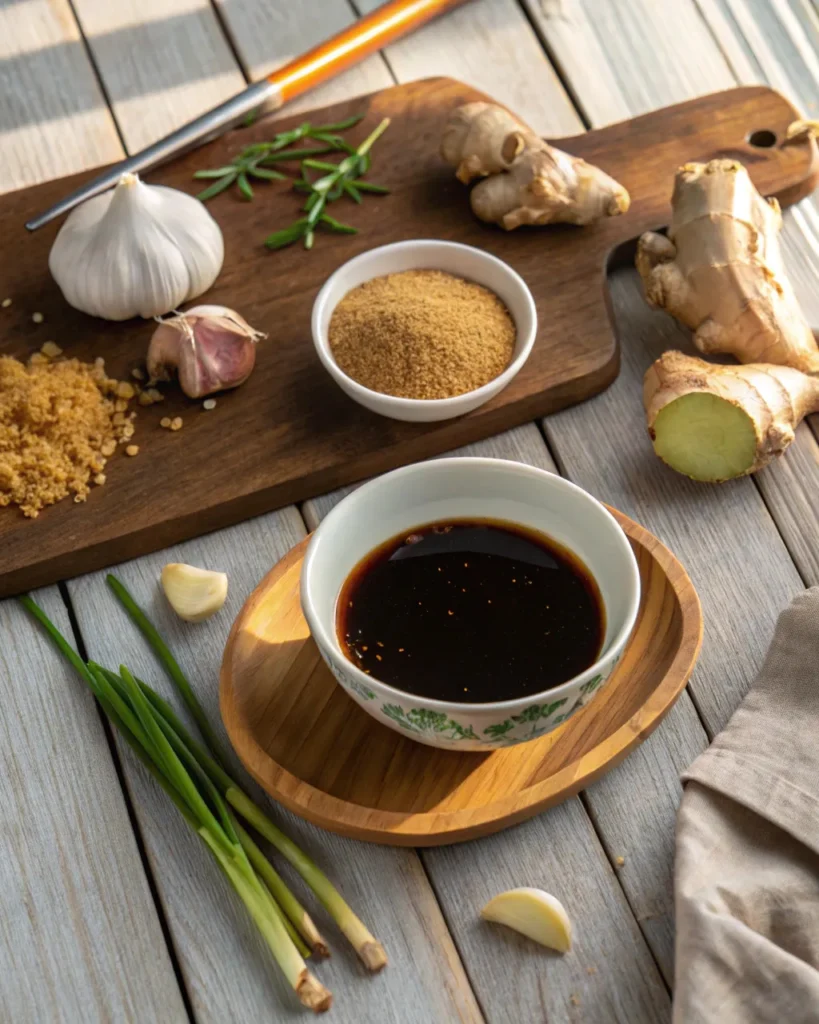
What Can I Marinate My Salmon In? The Go-To Ingredients
The star of any great teriyaki salmon recipe is the marinade. A well-balanced marinade does more than flavor your fish—it tenderizes and enhances every bite. Here’s what you’ll need for the most mouthwatering results:
- Low-sodium soy sauce – The base of any teriyaki sauce
- Brown sugar or honey – For that rich sweetness and caramelized finish
- Fresh garlic and ginger – Adds bold, aromatic depth
- Mirin or rice vinegar – Balances sweetness with gentle acidity
- Sesame oil – Optional, but it brings a warm, nutty depth that enhances the overall flavor.
- Crushed red pepper (optional) – For a subtle kick
Want to mix it up? Add a splash of orange juice, pineapple juice, or grated pear for a fruity twist that enhances the natural sweetness of the fish.
Looking for a deeper teriyaki flavor profile? Try this homemade teriyaki marinade recipe that works great for both chicken and fish.
Here’s a quick visual breakdown:
| Ingredient | Amount (for 4 fillets) | Purpose |
|---|---|---|
| Soy Sauce | 1/4 cup | Salty umami base |
| Brown Sugar | 2 tbsp | Adds sweetness and depth |
| Fresh Garlic | 2 cloves, minced | Sharp, savory flavor |
| Ginger | 1 tbsp, grated | Warm spice, pairs well w/ soy |
| Rice Vinegar | 1 tbsp | Acidity and brightness |
| Sesame Oil | 1 tsp | Nutty background note |
How Long Should You Marinate Salmon in Teriyaki Sauce?
Salmon is more delicate than beef or chicken, so it doesn’t need hours to soak up flavor. In fact, 15 to 30 minutes is perfect. Any longer and the marinade might start to break down the flesh, causing a mushy texture.
If you’re in a rush, even 10 minutes will do. If you’re prepping in advance, marinate in the fridge, and never leave it overnight—especially if your marinade contains acid like vinegar or citrus juice.
Quick Tips:
- Always marinate in a glass or ceramic dish, or use a zip-top bag.
- Keep it covered and chilled while marinating.
- Pat fish lightly dry before cooking to avoid excess liquid interfering with caramelization.
Pro Tips for an Even Marinade and Flavor Infusion
- Flip the fillets halfway through marinating to ensure even coating.
- Want more flavor? Reserve a bit of marinade before adding the raw fish, and brush it over the salmon during the final minute of cooking.
- Never reuse marinade that’s touched raw salmon unless you boil it first for at least 5 minutes.
Cooking Methods for the Juiciest Teriyaki Salmon
What Is the Tastiest Way to Cook Salmon? (Grill, Pan, Bake)
You’ve got options—and each one offers a slightly different experience. Here’s how to choose your method:
Grilling
Gives you that delicious smoky flavor and beautiful charred edges. Use a grilling basket or foil to prevent sticking, and cook skin-side down first.
Pan-Searing
Probably the fastest way to get a crispy skin and caramelized glaze. A hot non-stick or cast-iron pan is perfect. Just don’t crowd the pan—give each fillet breathing room.
Oven-Baking
Ideal for hands-off cooking. Place marinated salmon on a foil-lined sheet, bake at 400°F (200°C) for 12–15 minutes, and broil the last 2 minutes for a sticky finish.
Air Fryer
Quick and convenient! Set at 375°F and cook for 8–10 minutes, flipping once. Great for weeknights with no cleanup stress.
| Cooking Method | Time | Flavor Profile | Best For |
|---|---|---|---|
| Grill | 6–8 min | Smoky, charred | Summer meals |
| Pan-sear | 4–5 min/side | Crispy, rich | Quick dinners |
| Oven-bake | 12–15 min | Moist, mild | Bulk cooking |
| Air fryer | 8–10 min | Crisp outside, soft | Small portions |
Does Teriyaki Sauce Go On Before or After Cooking?
Both. Start by marinating the salmon to infuse it with flavor, then finish by brushing on additional sauce during or after cooking to achieve that signature glossy, sticky glaze.
Here’s how:
- Marinate before cooking.
- Pat salmon dry for a better sear.
- Brush with reserved sauce during the final minute of cooking or right after removing from heat.
That final brush-on glaze thickens quickly and gives your salmon a beautiful, caramelized finish.
Best Practices for Achieving a Sticky Glaze Without Burning
- Avoid using sugary sauces on high heat for too long—they burn fast.
- Use medium heat and finish with a quick broil or sear.
- Don’t walk away! Teriyaki can go from glossy to burnt in under a minute.
Pro Tip: A non-stick skillet helps prevent the sticky sugars from adhering to your pan. Cast iron works great too, but be ready to deglaze!
Step-by-Step Teriyaki Salmon Recipe
Ingredients List: Fresh, Simple, and Pantry-Friendly
This teriyaki salmon recipe is quick, easy, and built around ingredients you probably already have. You don’t need fancy tools—just fresh salmon and a few simple staples.
Salmon
- 4 salmon fillets (5–6 oz each), skin-on or skinless
- Salt and pepper, to taste
Teriyaki Marinade & Glaze
- ¼ cup low-sodium soy sauce
- 2 tablespoons brown sugar (or honey for natural sweetness)
- 1 tablespoon rice vinegar or fresh lemon juice
- 1 tablespoon grated ginger
- 2 garlic cloves, minced
- 1 teaspoon sesame oil (optional)
- 1 teaspoon cornstarch (for thickening glaze)
- 2 tablespoons water (to dissolve cornstarch)
Cooking Instructions for Stove, Oven, or Air Fryer
Step 1: Make the Teriyaki Marinade
In a small bowl, whisk together soy sauce, brown sugar, garlic, ginger, vinegar, and sesame oil. Separate about ⅓ of the mixture to use as a glaze later.
Step 2: Marinate the Salmon
Place salmon fillets in a glass dish or zip-top bag. Pour the marinade over the top. Let it sit for 15–30 minutes in the fridge. Flip once halfway.
Step 3: Cook the Salmon
Choose your method:
- Pan-sear: Heat oil in a skillet over medium heat. Cook salmon skin-side down first for 4–5 minutes. Flip and cook another 3–4 minutes until browned and cooked through.
- Bake: Preheat oven to 400°F (200°C). Place salmon on a foil-lined sheet and bake for 12–15 minutes.
- Air fryer: Set to 375°F, and cook for 8–10 minutes, flipping halfway.
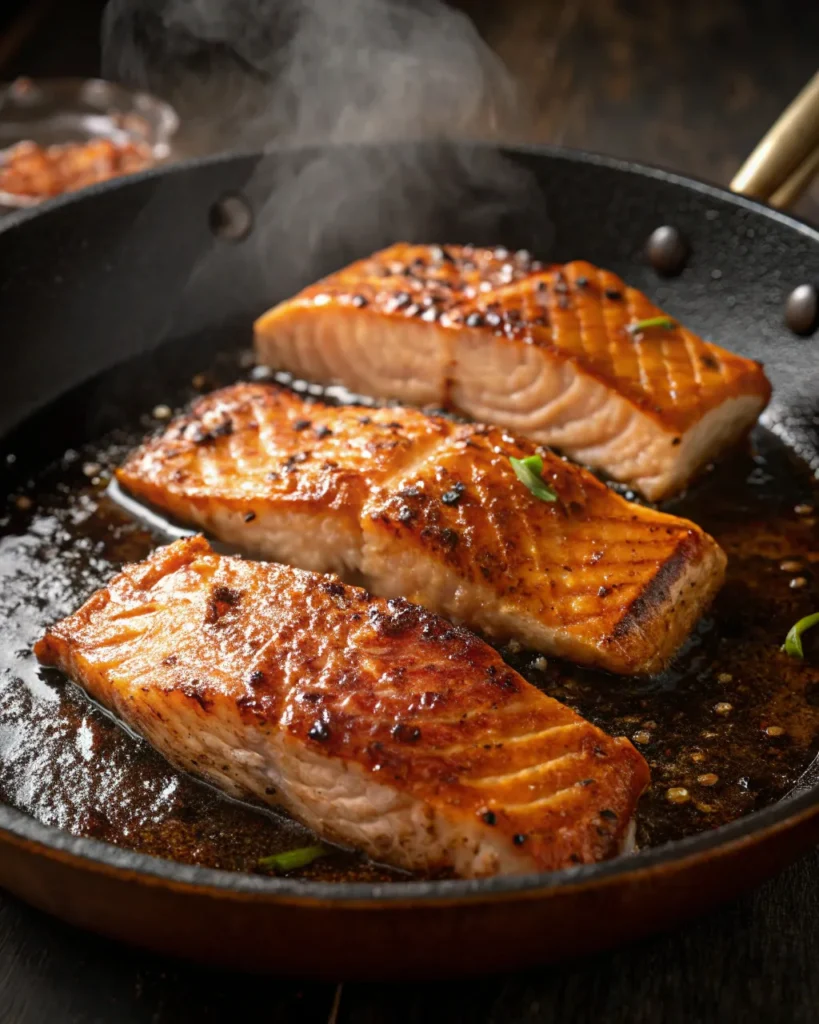
Step 4: Make the Glaze
Heat the reserved marinade in a saucepan. Stir in cornstarch mixed with water and bring to a boil. Simmer for 2 minutes until thick and glossy.
Step 5: Glaze and Serve
Brush the cooked salmon with the glaze and garnish with sesame seeds or sliced green onions if desired.
Storage and Reheating Tips to Maintain Flavor and Moisture
- Refrigerator: Keep leftovers in an airtight container and store for up to 3 days to maintain freshness and flavor.
- Reheat: Warm in the oven at 300°F for 10 minutes, or in the microwave in 30-second bursts.
- Freezer: Freeze cooked salmon (without glaze) for up to 2 months. Thaw in the fridge overnight before reheating.
Pro Tip: Keep extra glaze in a separate container so you can add a fresh burst of flavor when reheating.
Side Dishes That Make Teriyaki Salmon Shine
Perfect Rice Pairings: Jasmine, Sushi Rice, or Brown?
Salmon and rice are a classic duo. The tender flakiness of the fish pairs beautifully with the soft bite of steamed rice.
Here are top rice options:
| Type of Rice | Flavor Note | Cook Time |
|---|---|---|
| Jasmine | Light, floral | 15–20 mins |
| Sushi Rice | Sticky, starchy | 20–25 mins |
| Brown Rice | Nutty, hearty | 30–35 mins |
| Cauliflower Rice | Low-carb, mild | 5–7 mins |
Want more flavor? Add a splash of rice vinegar and sesame oil to plain white rice for a quick upgrade.
Vegetables That Complement Teriyaki Salmon Beautifully
Balance out the sweet-savory richness of the teriyaki glaze with something crisp and colorful.
Top choices:
- Steamed broccoli or broccolini
- Snow peas or sugar snap peas
- Carrot ribbons with sesame
- Sauteed bok choy
- Roasted green beans or asparagus
Toss veggies in a touch of sesame oil and soy sauce, or roast them with garlic for an extra pop of flavor.
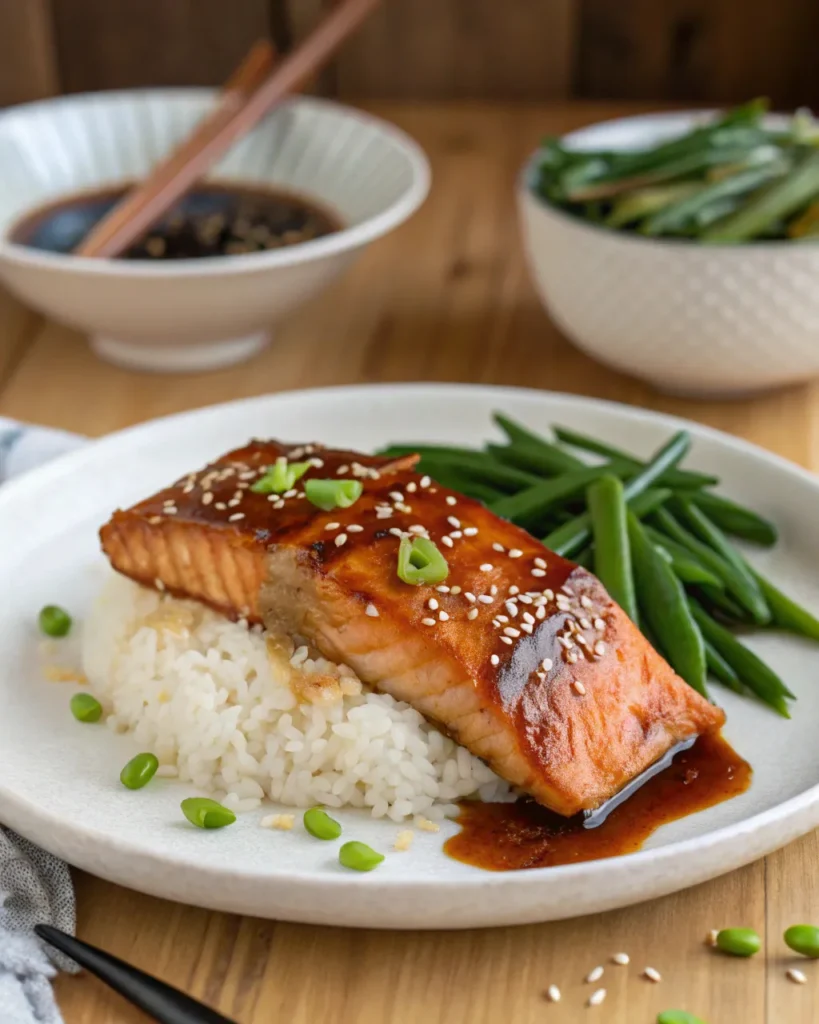
Asian-Inspired Salads and Noodle Options
Sometimes, a light salad or noodle bowl hits the spot.
Try pairing your salmon with:
- Cold soba noodle salad with shredded cucumber and sesame dressing
- Cabbage slaw with rice vinegar, ginger, and toasted sesame seeds
- Glass noodles with chili oil and scallions
- Seaweed salad with sesame and citrus zest
These sides are not only flavorful—they’re also a refreshing counterbalance to the warmth and richness of the salmon dish.
Sauces That Go Best with Salmon Beyond Teriyaki
Which Sauce Goes Best with Salmon Besides Teriyaki?
Teriyaki is a classic, but it’s not the only sauce that brings out the best in salmon. This fish is versatile, which means it pairs well with a range of flavor profiles—from zesty and creamy to spicy and tangy. If you’re craving variety, try switching things up with these tried-and-true sauces:
- Lemon dill sauce – Light, citrusy, and perfect for summer meals
- Garlic miso glaze – Savory, rich, and slightly funky (in a good way)
- Honey mustard – Sweet with a tang, works great with grilled salmon
- Maple soy glaze – Similar to teriyaki, but with more depth from maple syrup
- Chimichurri – Herby and bold, especially great if grilling your salmon
Homemade Citrus Soy Glaze, Garlic Miso, or Lemon Dill
Want to make these sauces at home? Here’s a basic outline for three quick favorites:
1. Citrus Soy Glaze
- ¼ cup soy sauce
- 2 tbsp orange juice
- 1 tbsp honey
- ½ tsp fresh ginger
Simmer in a pan until thickened.
2. Garlic Miso Glaze
- 1 tbsp white miso paste
- 2 tsp soy sauce
- 1 tbsp mirin
- 1 minced garlic clove
Mix and gently heat until smooth.
3. Lemon Dill Sauce
- ¼ cup Greek yogurt or sour cream
- 1 tbsp fresh lemon juice
- 2 tsp chopped fresh dill
- Salt and pepper to taste
Stir and chill before serving.
These sauces add depth and diversity to your weekly dinner rotation, and they’re simple enough to whip up in minutes.
How to Pair Sauces with Cooking Styles and Sides
The right sauce should complement not just your salmon, but the entire plate. Here’s how to match sauces with cooking styles and sides:
| Sauce Type | Best Cooking Method | Ideal Side Pairings |
|---|---|---|
| Teriyaki | Pan-seared or baked | Jasmine rice, stir-fried veggies |
| Lemon Dill | Oven-baked | Roasted potatoes, steamed greens |
| Garlic Miso | Grilled or pan-seared | Soba noodles, bok choy |
| Citrus Soy | Air fryer or skillet | Cauliflower rice, sautéed kale |
Pro Tip: Always taste your sauce with a bite of salmon before serving. If it’s too strong, lighten it with a bit of water or citrus.
Healthy Benefits of Eating Teriyaki Salmon
Why Salmon Is a Smart Choice for Heart and Brain Health
Salmon isn’t just delicious—it’s one of the most nutritious proteins you can add to your weekly meals. It’s high in omega-3 fatty acids, which are proven to support:
- Heart health by lowering blood pressure
- Brain function and memory
- Joint health and inflammation reduction
- Eye health, especially with age
A 6-ounce serving of salmon contains roughly 1,500 mg of omega-3s, plus 25 grams of lean protein, making it a nutrient powerhouse.
Is Teriyaki Sauce Healthy? What to Know About Sugar and Sodium
Traditional teriyaki sauce can be high in sodium and sugar, especially the bottled versions. That doesn’t mean you can’t enjoy it—you just need to make smart swaps:
| Ingredient | Standard Teriyaki | Healthier Alternatives |
|---|---|---|
| Soy Sauce | High sodium | Low-sodium soy or tamari |
| Sugar | Refined sugar | Honey, maple syrup, or coconut sugar |
| Cornstarch (for thickening) | Simple starch | Arrowroot or xanthan gum |
Making your own sauce at home means you control the ingredients. Add extra garlic and ginger for flavor without relying on sugar or salt.
Making a Lower-Sodium or Gluten-Free Version of Teriyaki Sauce
To keep your teriyaki salmon recipe healthy and accessible, consider these smart adjustments:
- Swap in tamari or coconut aminos for soy sauce to keep the recipe completely gluten-free without sacrificing flavor.
- Reduce sugar by half and add a splash of pineapple juice for natural sweetness.
- Skip the sesame oil if you’re watching fat intake, or use just a few drops.
Healthy eating doesn’t mean sacrificing flavor. With a few tweaks, you can enjoy all the richness of teriyaki salmon—with less guilt and more nutrition.
Common Questions About Cooking Teriyaki Salmon (FAQs)
Does teriyaki sauce go well with salmon?
Absolutely. The sweet-savory balance of teriyaki sauce enhances the rich, buttery flavor of salmon, making it one of the most popular and reliable seafood pairings.
How long should you marinate salmon in teriyaki sauce?
Marinate your salmon for 15 to 30 minutes. That’s enough time for flavor absorption without making the flesh mushy or overcured.
Does teriyaki sauce go on before or after cooking?
Both. Use it as a marinade before cooking, then brush more on during the last minute or after cooking for a glossy, sticky finish.
What is the tastiest way to cook salmon?
For flavor and texture, pan-searing or oven-baking are top choices. Pan-searing gives a crispy skin, while baking is tender and hands-off.
Which sauce goes best with salmon?
Besides teriyaki, other favorites include lemon dill, garlic miso, and citrus soy glazes. Each sauce gives a unique flavor profile depending on your craving.
What can I marinate my salmon in?
Great options include teriyaki sauce, soy-ginger-lime, honey mustard, or maple dijon marinades. Always balance sweet, salty, and acidic elements for the best results.
Conclusion
Making a teriyaki salmon recipe at home is easier than you think. With a handful of pantry staples and fresh salmon, you can serve up a meal that’s not only packed with flavor, but also heart-healthy, kid-approved, and dinner-party ready.
From choosing the right fillets to mastering the perfect teriyaki glaze, everything in this guide was crafted to help your salmon shine—crispy on the outside, flaky on the inside, and glazed to perfection.
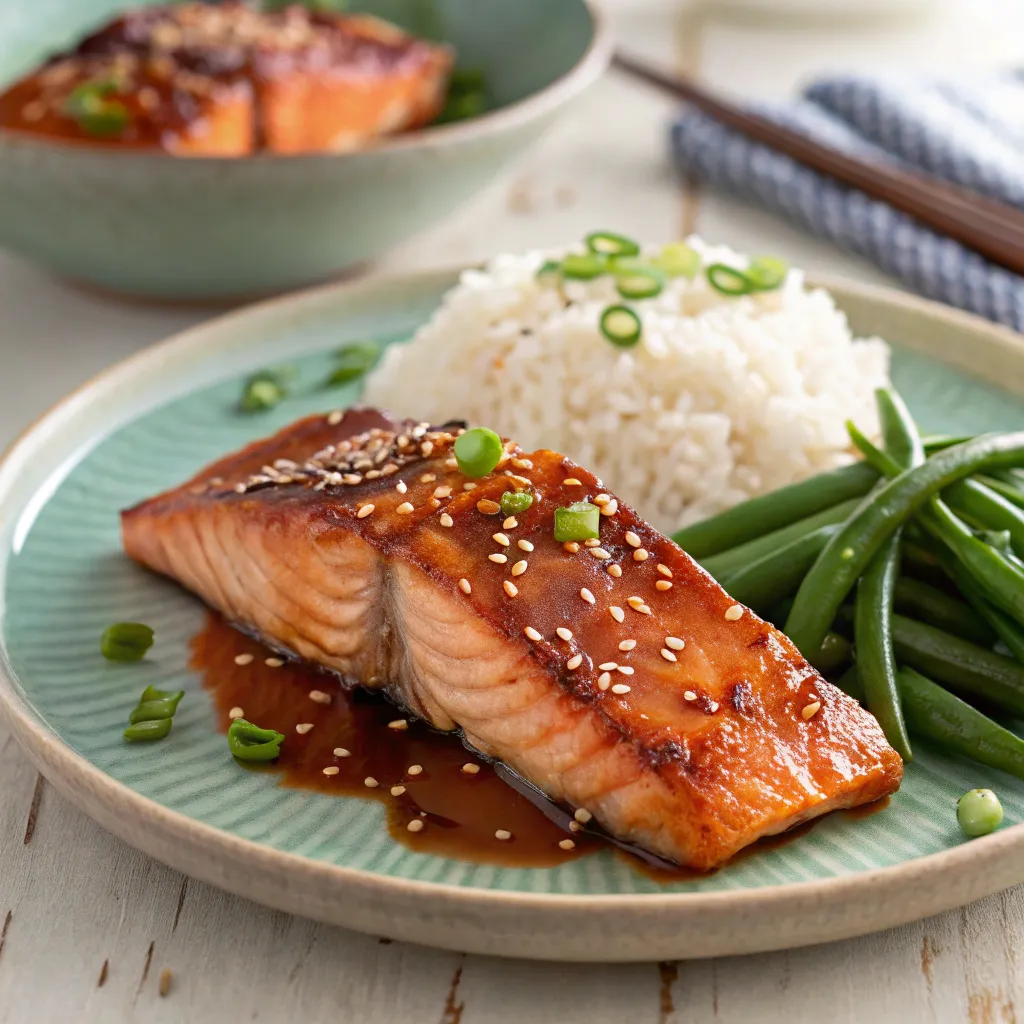
Teriyaki Salmon Recipe
Ingredients
Equipment
Method
- In a bowl, mix soy sauce, brown sugar, garlic, ginger, rice vinegar, and sesame oil. Set aside a portion for glaze.
- Place salmon in a dish or zip-top bag and pour marinade over. Chill for 15–30 minutes.
- Sear in a skillet, bake at 400°F for 12–15 minutes, or air fry at 375°F for 8–10 minutes.
- Simmer reserved marinade in a saucepan. Stir in cornstarch mixed with water. Cook until thickened.
- Brush glaze over salmon before serving. Garnish with sesame seeds or scallions if desired.
Notes
- Pro Tip: Store extra glaze separately and reheat with leftovers for refreshed flavor.
- Storage: Keep leftovers in an airtight container in the fridge for up to 3 days.


